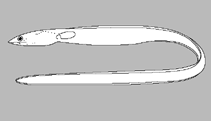Neenchelys gracilis Ho & Loh, 2015
Fringe-nose worm-eel
Upload your photos and videos
Google imageNo image available for this species;
drawing shows typical species in Ophichthidae.
Google imageNo image available for this species;
drawing shows typical species in Ophichthidae.
Classification / Names Common names | Synonyms | Catalog of Fishes(genus, species) | ITIS | CoL | WoRMS | Cloffa
Teleostei (teleosts) > Anguilliformes (Eels and morays) > Ophichthidae (Snake eels) > Myrophinae
Etymology: Neenchelys: Name from Greek 'neo' for new and 'enchelys' for eel; gracilis: The specific name 'gracilis' means slender or slim, refreeing to its very slim body.
Etymology: Neenchelys: Name from Greek 'neo' for new and 'enchelys' for eel; gracilis: The specific name 'gracilis' means slender or slim, refreeing to its very slim body.
Environment: milieu / climate zone / depth range / distribution range Ecology
Marine; demersal; depth range ? - 400 m (Ref. 106137). Subtropical
Distribution Countries | FAO areas | Ecosystems | Occurrences | Point map | Introductions | Faunafri
Northwestern Pacific: Taiwan.
Size / Weight / Age
Short description Identification keys | Morphology | Morphometrics
Vertebrae: 200. This species is distinguished by the following characters: with a minute pectoral fin, many filamentous cirri on anterior nostril rim; a very small gill opening (3.8% HL); body depth 4.7 times in HL, 77 in TL; dorsal-fin origin in anterior, 1/3 of trunk, 1.7 times HL behind the gill opening; predorsal length 6.0 in TL; head relatively is short, 16.2 in TL; trunk 3.1 in TL; tail long, 1.6 in TL; pectoral fin a minute flap with some visible rays; total vertebrae 200; VF 30-78-200l; cephalic lateral-line pores 11; predorsal pores 33; preanal pores 78; total pores 169, the last 1.5 times HL before tail tip (Ref. 106137).
This species was collected by fishery otter trawl in the same haul with many macrourids, ophidiids, deep-sea shrimps and other demersal fishes that would suggest a benthic habit (Ref. 106137).
Life cycle and mating behavior Maturity | Reproduction | Spawning | Eggs | Fecundity | Larvae
Main reference
Upload your references | References | Coordinator : McCosker, John E. | Collaborators
Ho, H.-C. and K.-H. Loh, 2015. A new species of the worm-eel genus Neenchelys (Anguilliformes: Ophichthidae) from southern Taiwan. Zootaxa 4060(1):52-55. (Ref. 106137)
CITES
Not Evaluated
Threat to humans
Harmless
Human uses
Fisheries: bycatch
FAO - Publication: search | FishSource |
More information
Trophic ecology
Food items
Diet composition
Food consumption
Food rations
Predators
Food items
Diet composition
Food consumption
Food rations
Predators
Ecology
Ecology
Ecology
Population dynamics
Growth parameters
Max. ages / sizes
Length-weight rel.
Length-length rel.
Length-frequencies
Mass conversion
Recruitment
Abundance
Growth parameters
Max. ages / sizes
Length-weight rel.
Length-length rel.
Length-frequencies
Mass conversion
Recruitment
Abundance
Life cycle
Reproduction
Maturity
Maturity/Gills rel.
Fecundity
Spawning
Spawning aggregations
Eggs
Egg development
Larvae
Larval dynamics
Reproduction
Maturity
Maturity/Gills rel.
Fecundity
Spawning
Spawning aggregations
Eggs
Egg development
Larvae
Larval dynamics
Anatomy
Gill area
Brain
Otolith
Gill area
Brain
Otolith
Physiology
Body composition
Nutrients
Oxygen consumption
Swimming type
Swimming speed
Visual pigments
Fish sound
Diseases & Parasites
Toxicity (LC50s)
Body composition
Nutrients
Oxygen consumption
Swimming type
Swimming speed
Visual pigments
Fish sound
Diseases & Parasites
Toxicity (LC50s)
Genetics
Genetics
Heterozygosity
Heritability
Genetics
Heterozygosity
Heritability
Human related
Aquaculture systems
Aquaculture profiles
Strains
Ciguatera cases
Stamps, coins, misc.
Aquaculture systems
Aquaculture profiles
Strains
Ciguatera cases
Stamps, coins, misc.
Tools
E-book | Field guide | Length-frequency wizard | Life-history tool | Point map | Classification Tree
| Catch-MSY |
Special reports
Download XML
Internet sources
AFORO (otoliths) | Aquatic Commons | BHL | Cloffa | BOLDSystems | Websites from users | Check FishWatcher | CISTI | Catalog of Fishes: genus, species | DiscoverLife | ECOTOX | FAO - Publication: search | Faunafri | Fishipedia | Fishtrace | GenBank: genome, nucleotide | GloBI | Google Books | Google Scholar | Google | IGFA World Record | MitoFish | National databases | Otolith Atlas of Taiwan Fishes | PubMed | Reef Life Survey | Socotra Atlas | Tree of Life | Wikipedia: Go, Search | World Records Freshwater Fishing | Zoobank | Zoological Record
Estimates based on models
Phylogenetic diversity index (Ref. 82804): PD50 = No PD50 data [Uniqueness, from 0.5 = low to 2.0 = high].
Bayesian length-weight: a=0.00076 (0.00029 - 0.00197), b=3.06 (2.83 - 3.29), in cm total length, based on LWR estimates for this (Sub)family-body shape (Ref. 93245).
Trophic level (Ref. 69278): 4.1 ±0.7 se; based on size and trophs of closest relatives
Resilience (Ref. 120179): High, minimum population doubling time less than 15 months (Preliminary K or Fecundity.).
Fishing Vulnerability (Ref. 59153): Low to moderate vulnerability (33 of 100).




